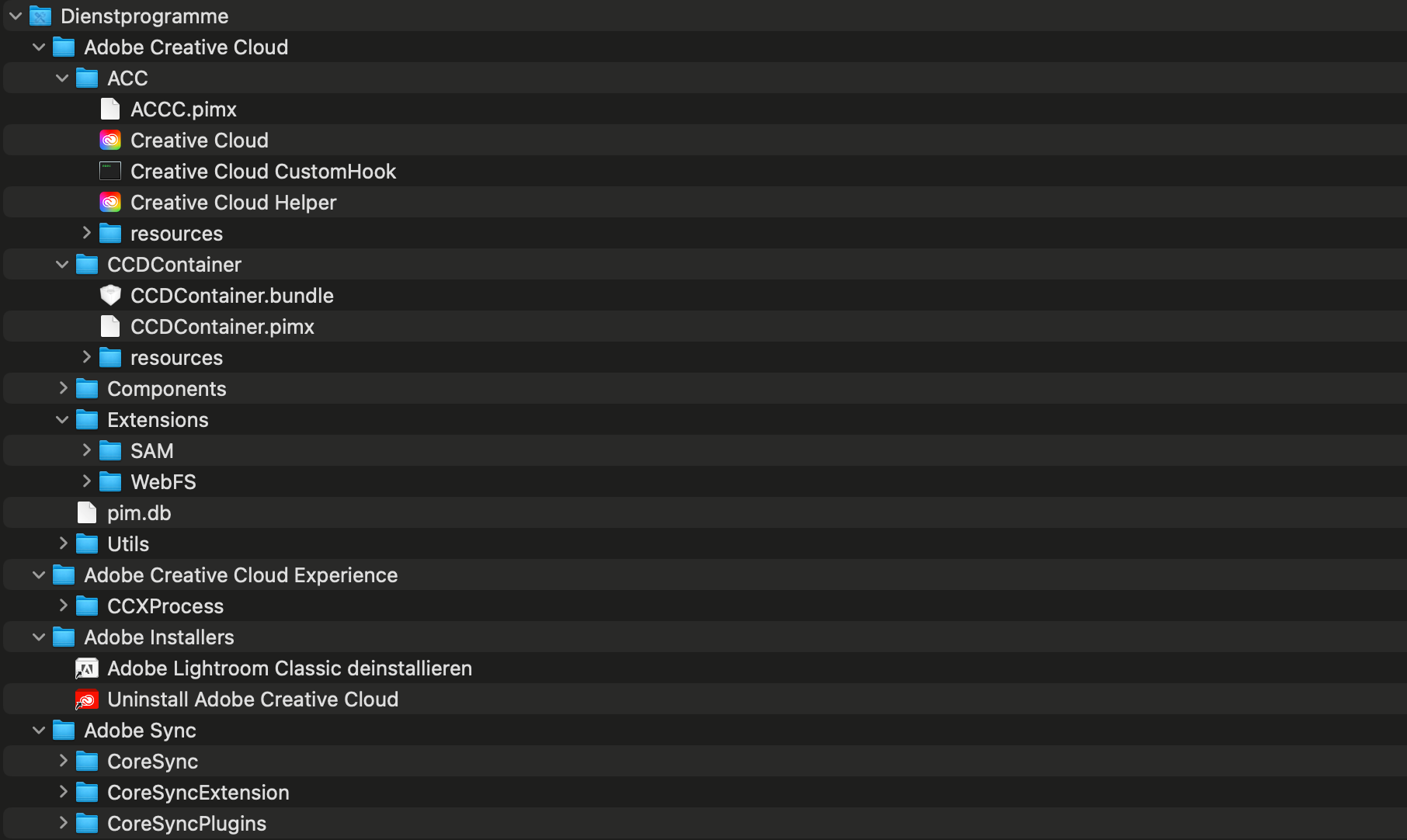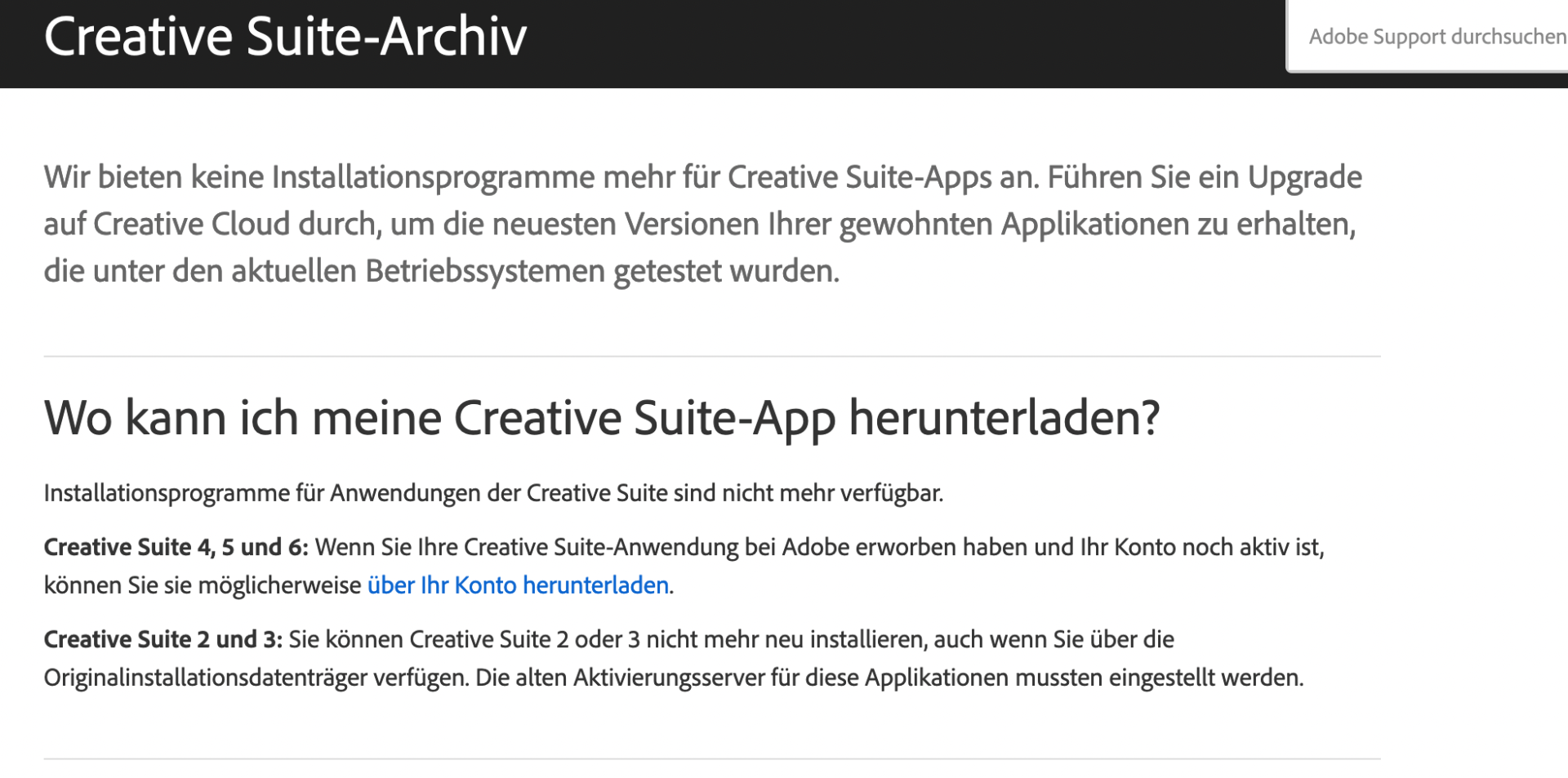[BLOG] GOODBYE ADOBE
I’ve been working with software from Adobe for years. I remember photoshoping my first photos in school and editing my first video in Premiere when I was 15. It took years to learn, and even more to be good enough to make a living with it. But times change and over the last 6 or so years, I got more and more reluctant to use it.
And I’m not the only one. But to spot the exact reasons felt difficult, except the change to subscription-only model, which annoyed many. So I collected information to show why it is bloated, buggy, expensive, unfair, probably privacy invading and not even up-to-date. And why I’m still using it nonetheless.
The Homecalling of Adobe Software
Let’s start with a pretty annoying behavior – permanent background homecalling, with no option to opt-out. On a fresh install on a M1 Mac I saw massive ammount of connections made.
1. During a simple install of Lightroom Classic, Adobe connects to more than 60 different servers.
One on which was my home router on 192.168.x.x, which I find especially disturbing. I don’t need to go deep into that to point out that spawning 8 processes and making 60 connections to simply download one app is way too bloated. Note, that there is no way to install an app without all the Adobe Cloud components anymore.
Here are all the called destinations:
Process: Setup
a1883.dscd.akamai.net
ccmdls.adobe.com
cdn-ffc.oobesaas.adobe.com
d1n897799gitxr.cloudfront.net
ccmdls-stls-cn-adobe.com.edgesuit.net
a1883.dscd.akamai.net
23.32.238.129
ccmdls.adobe.com
94.245.192.57
ccmdls.adobe.com
23.32.238.129
94.245.192.56
23.32.238.104
94.245.192.57
Process: node
platform-cs.adobe.io
libraries.adobe.io
lcs-cops.adobe.io
cc-api-storage.adobe.io
public.adobecc.com
ims-prod06.adobelogin.com
cclibraries-defaults-cdn.adobe.com
Process: Adobe_CCXProcess.node
lcs-cops.adobe.io
local IP address: 192.168.X.X
ims-prod06.adobelogin.com
ab.adobe-identity.com
as1.ftcdn.net
as2.ftcdn.net
cc-api-data.adobe.io
helpx.adobe.com
ims-prod06.adobelogin.com
mir-s3-cdn-cf.behance.net
odin.adobe.com
p13n.adobe.io
publish-p22655-e59433.adobeaemcloud.com
stock.adobe.io
Process: Lightroom Classic Installer
connect.ffc.adobeoobe.com
na1e-acc.services.adobe.com
cdn-ffc.oobesaas.adobe.com
ars.oobesaas.adobe.com
prod-rel-ffc-ccm-oobesaas.adobe.com
ets-prd2-uw1-coll-elb-2013165758.us-west-2.elb.amazonaws.com
ims-prod07.adobelogin.com
52.50.166.115
52.50.133.93
use.typekit.net
oobe.adobe.com
server.messaging.adobe.com
Process: Adobe Desktop Service
cc-api-data.adobe.io
ims-prod06.adobelogin.com
Process: Creative Cloud Helper via Adobe
ims-prod06.adobelogin.com
lcs-cops.adobe.io
Process: Core Sync
cc-api-data.adobe.io
polka.typekit.com
state.typekit.net
Process: Creative Cloud
client.messaging.adobe.com
cchome.adobe.io
prod.adobeccstatic.com
mir-s3-cdn-cf.behance.net
use.typekit.netI continued to watch the connections and soon realized
2. Adobe constantly connects to various servers, even when no Adobe programs are running.
After exiting Lightroom Classic, a service called LogTransport2 wants to make a connection to hbrcv.adobe.com. And even after disabling Sync and closing all automatically installed Adobe Applications like Adobe Creative Cloud, the services Core Sync and Node are still trying to reach different destinations. There’s no normal way to exit Adobe programs on your own computer. This is basically the behavior of malware.
3. Adobe makes it difficult to impossible to opt-out of data gathering and analysis.
During setup you are asked to accept all data gathering. There is a note that if you want to opt-out, you need to go to Adobes website and basically find the checkbox yourself. I tried that, and it’s nearly impossible to find. I guess that’s on purpose.
Adobe likes personal data
What you may not know is that Adobe also sells products for real-time user tracking on the internet. The platform is called Adobe Experience Cloud. It’s funny when you read the website you realize how desperately they prevent the use of terms like “tracking”, instead they talk about “AI-driven solutions for marketing, analytics, advertising, and commerce through the most comprehensive set of customer experience applications and services available.”
On their website, they also promote that they can “Gather data from every source.”. But they’re not saying that they use one of the most shady methods to get those datasets.
My colleague Erich Möchl recently pointed out, that according to a study about DNS based tracking, Adobe Experience Cloud is the second most provider of the questionable method of CNAME tracking, which tricks the browsers to load third-party cookies by pretending that they are cookies from the first-party. According to the study, this also leads to vulnerabilities and sensitive data being leaked to CNAME-based trackers like Adobe Experience Cloud. “Through manual analysis we found that sensitive information such as email addresses and authentication cookies leak to CNAME trackers on sites where users can create accounts.”
With Adobe being in this business, the picture of why there are so many connections being made in Adobe Creative Cloud gets clearer. The problematic thing is, that you can’t opt-out. You are forced to install all those additional software and let it communicate for continuous activation.
4. Several additional sync and cloud apps are installed, even if you don’t want or need them

This is called bloatware.
I never asked for Sync or Creative Cloud, only “Adobe Lightroom Classic”. If you try to uninstall Adobe Creative Cloud, it refuses to do so until you uninstalled all the other Adobe apps as well.

The Subscription model
It’s obviously a trend to make software available via subscription only. After all, this makes you spend more money after continues use. There’s no doubt that those pricing models don’t favor their users. But it has another consequence:
5. The subscription-only model makes the software to be constantly under development, there’s never a finished, stable version.
At the TV Station I work at we are dependent on Adobe Premiere. In my team we had three machines which we didn’t want to upgrade all the time. One good setup should be locked for a couple of years on these editing systems so that they are well tested and functional. Turns out, that it’s impossible to find a version without major bugs. Early in the release circle, the software feels very much like beta. Later in the release circle, they fix the initial bugs but introduce new functions which will then again introduce new bugs. It’s frustrating. It adds to the image that Adobe wants you to permanently be connected and dependent on their services.

No Internet, no Adobe
Maybe the biggest issue I discovered is about the need of an internet connection.
6. Even when you buy a 12 year subscription and pay in advance, Adobe will deactivate the software on your computer regularly if you’re not connected to, or don’t let it connect to the Internet.
This is critical, especially for professionals. Imagine being on a film shooting out on the fields, with no internet coverage and all of the sudden Adobe denies to start up. Or imagine people in rural areas with bad or not internet connection – they can’t trust in the software and are left out.
7. It is expensive.
Adobe, if you’re listening – We want simple and safe tools, which we can trust. We want choice whether we want data in a cloud or not. We want to have the opportunity to work local without an internet connection. Not to mention those, who might not have a permanent internet connection. We don’t want to be spied on. We hate buggy software. We either have it working well than new features every few months.
Alternatives
Let’s have a quick look at the alternatives, which are partially mindblowingly good. The company Serif offers the Affinity Suite, an excellent alternative for Photoshop, InDesign and Illustrator. No subscription fee, one-time payment! Blackmagicdesign has some serious magic going on with their Resolve video editing and grading software. This is not only much more perfomant than everything I’ve seen from Adobe, it also includes video editing, audio editing with a full featured DAW, grading and graphics in one single software package. And, you know what? The basic version is free. I can’t stress that enough. It’s free. All the tools most users will ever need are free to use.
The one thing I haven’t found any good alternative is Lightroom Classic. There are projects like Capture One but especially when it comes to photo library management it’s not quite there yet. I’m currently giving the nice Open Source Software Rawtherapee a try. Looks promising so far. If you have suggestions, I’m happy to hear them!
The hurdles of switching
Switching software which took years to learn is a tedious task. There’s an enormous amount of time beeing invested in learning a specific program. And stolid companys rely on them, they won’t switch while their systems are heavily integrated and rely on this specific software. They’re stuck too.
If you decide to switch, you’ll end up with the software you use and like, but with which you’re not as good at, while simultaniously still beeing depended on Adobe. And Adobe knows that.
But times change. My subscription is running out in june. There are new and innovative tools which really are about you and helping you to tell the stories you have in your mind. To me, bad software is like bad food – better avoided.